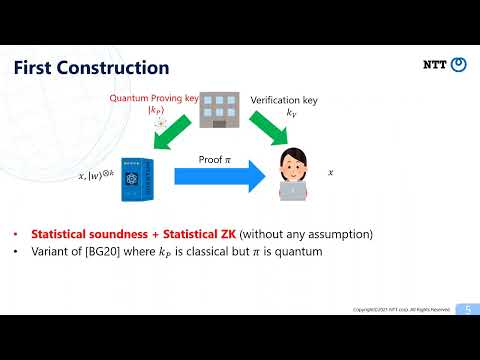CryptoDB
Classically Verifiable NIZK for QMA with Preprocessing
| Authors: |
|
|---|---|
| Download: | |
| Presentation: | Slides |
| Conference: | ASIACRYPT 2022 |
| Abstract: | We propose three constructions of classically verifiable non-interactive zero-knowledge proofs and arguments (CV-NIZK) for QMA in various preprocessing models. 1. We construct a CV-NIZK for QMA in the quantum secret parameter model where a trusted setup sends a quantum proving key to the prover and a classical verification key to the verifier. It is information theoretically sound and zero-knowledge. 2. Assuming the quantum hardness of the learning with errors problem, we construct a CV-NIZK for QMA in a model where a trusted party generates a CRS and the verifier sends an instance-independent quantum message to the prover as preprocessing. This model is the same as one considered in the recent work by Coladangelo, Vidick, and Zhang (CRYPTO ’20). Our construction has the so-called dual-mode property, which means that there are two computationally in-distinguishable modes of generating CRS, and we have information theoretical soundness in one mode and information theoretical zero-knowledge property in the other. This answers an open problem left by Coladangelo et al, which is to achieve either of soundness or zero-knowledge information theoretically. To the best of our knowledge, ours is the first dual-mode NIZK for QMA in any kind of model. 3. We construct a CV-NIZK for QMA with quantum preprocessing in the quantum random oracle model. This quantum preprocessing is the one where the verifier sends a random Pauli-basis states to the prover. Our construction uses the Fiat-Shamir transformation. The quantum preprocessing can be replaced with the setup that distributes Bell pairs among the prover and the verifier, and therefore we solve the open problem by Broadbent and Grilo (FOCS ’20) about the possibility of NIZK for QMA in the shared Bell pair model via the Fiat-Shamir transformation. |
Video from ASIACRYPT 2022
BibTeX
@inproceedings{asiacrypt-2022-32352,
title={Classically Verifiable NIZK for QMA with Preprocessing},
publisher={Springer-Verlag},
author={Tomoyuki Morimae and Takashi Yamakawa},
year=2022
}

